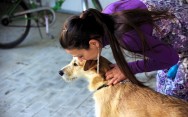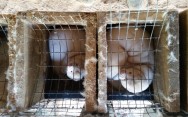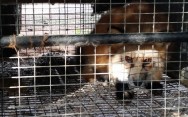Blog Archives
Home -
Archive by category "Animal rights" (Page 2)
In an exciting breakthrough for research in animal communication, the SETI institute managed to
have the first ever conversation with a humpbacked whale. The SETI institute began as a NASA
research program to understand and search for life beyond earth. The Whale-SETI team is using the
mathematics of information theory to understand terrestrial, non-human communication as a way
to develop filters to apply to any communication with extraterrestrial life.
Humpback whales are social and intelligent creatures who make tools and communicate with songs
and social calls. The Whale-SETI team has been studying humpback whale communication, which
include “contact calls” that whales use to communicate their presence to other whales. The team of
scientists from the SETI Institute, UC Davis and the Alaska Whale Foundation played the contact calls
into the sea via an underwater speaker, and a humpback whale named Twain approached and
circled the team’s boat while responding in a style that matched the original contact signal. The
researchers managed to have a 20 minute conversation with Twain. It is the first known
“conversation” between humans and humpback whales. Humpback whales also display non-audio
communicative behavior when they blow bubble rings in the presence of humans.
Whale SETI may be viewed as a springboard for communicating with extraterrestrial life. However
communication with animals could have more immediate benefits for animals in our world, right
now. Whales are one of the marine creatures who are profoundly affected by human activity. Whale song is disrupted by the noise of ships. If we can communicate with non-human animals our decision making should consider them as equal participants.
Humans have erroneously viewed human communication as synonymous with superior intelligence.
Without the ability to communicate with other animals and with a so-called superior intelligence
human activity has rampaged throughout animal habitats without the consent of animals. Every step
towards understanding animal intelligence and communication provides further evidence that these
assumptions are wrong. Scientific knowledge should not dictate our respect for non-human animals,
however scientific discovery can provide a basis for progressive animal rights policy and zero
tolerance for cruelty towards non-human lives.
|
Tags: Animal Communication,
Animal Habitats,
Animal Intelligence,
animal rights,
Humpbacked Whale,
Kevin Boileau,
Marine Animals,
Nazarita Goldhammer,
Transhumanist,
Whale Communication,
Whale Song
South Korea’s dogmeat trade has long been a national source of shame, especially to younger
people, who have developed more progressive views about animals. Pets such as domestic dogs and
cats have become more popular, changing people’s views of dogs as disposable animals that can
be farmed for meat. The dogmeat trade has been dying out on its own, but it has lingered on. The
dog meat trade is incredibly cruel and dogs are often killed in extremely painful ways. Dogs are kept
caged and suffer cruel conditions where they see other dogs killed. As social animals, this must be
unbearable to them.
Last year, South Korea’s parliament voted near unanimously to ban the dog meat industry. The law
takes effect in 2027 and will ban any future slaughter breeding and sale of dogs for dog meat.
The consumption of dog meat is based on historical traditions and unscientific beliefs about the
health benefits of dog meat. One of the most horrifying things about these traditions is that dogs are
deliberately tortured before death because of the belief that the adrenaline levels in the animal will
contribute to health benefits. Although dog meat was traditionally eaten in South Korea in the past,
there is evidence that this was not widespread and it became more popular due to false beliefs
about its effects on virility in older men. Animals have long been tortured because of human crazes
and the dog meat industry is a particularly cruel example. Not only are animals farmed for dog meat
but also abandoned pets are collected from the streets and slaughtered for the dog meat trade.
Activists inside and outside of the countries where dog meat is eaten have protested the practice.
On the other hand, condemning the practice has been associated with anti-Asian racism in incidents
in the US where restaurants have been falsely accused of selling dog meat. Consuming dog meat is
not “barbaric” because of a country’s culture, it is barbaric because humans are capable of extreme
cruelty towards animals when it is in their own interests.
Although it’s positive that dogs will be protected from this horrific cruelty in the future, the dog
meat ban should not draw attention away from the suffering of all animals such as cows, which in
Western culture are slaughtered for meat while in Korean culture traditionally were not killed and
kept as work animals. Animal rights activists and philosophers have argued against “speciesism,” in
which some animals are considered more deserving of safety than others. Banning dog meat is a
reflection of the public’s increasing intolerance of cruelty toward animals that are kept as pets.
Ultimately we must fight for animal rights to be extended beyond pets and towards all animals.
|
Tags: Animal Breeding,
Animal Cruelty,
animal rights,
Animal Suffering,
Cruelty to Dogs,
Dogmeat Industry,
Kevin Boileau,
Nazarita Goldhammer,
Speciesism,
Transhumanism,
Vegan
Animal welfare services are investigating the Ontario marine park where 14 whales and 1 dolphin have died in the space of a few years. The park is a big employer in the area and it has denied any wrongdoing, including any water quality issues that could have led to deaths at the park.
The park has a vested interest in keeping animals in roles where they are visible to the public, and formerly held shows in which its animals performed tricks and members of the public could feed its animals.
During a 2 year period, 12 beluga whales died. At the same time, provincial authorities had raised concerns about the park’s water quality and had recognized that all of the marine mammals were in distress. There have been protests and demonstrations for many years against the treatment of animals in the park. Citations against the park have resulted in 5 counts of animal cruelty by the Ontario Society for the Prevention of Cruelty to Animals in 2016 and 6 counts of cruelty by the OSPCA in 2017.
The animals that died include a beluga whale named Ikora, who died on October 24th 2019 and 10 others including a beluga named Bull, who died on November 23, 2021. 3 more deaths were confirmed in 2023, including Kisko, who was called “the world’s loneliest whale.” She was the last killer whale in captivity in Canada, and was originally captured along with Keiko, the star of Free Willy. She endured loneliness throughout her life in captivity, as she was confined to a small tank without companions. She died at the age of 47. The other animals who died in 2023 were a dolphin and a whale.
At one time Marineland had the most captive belugas in the world. Since Canada passed a law phasing out marine captivity, the park was forced to adjust. It is now shifting towards educational efforts. The animals are no longer available to the public and forced to perform tricks.
The lack of information surrounding the deaths of these animals obscures the conditions they may have been living in before they died. Captivity not only exposes animals to psychological risks of loneliness and confinement and the psychological pressure of being on display, animals could also suffer from neglect, poor environmental conditions and chronic health issues. Marine animal captivity should not be the norm unless it is explicitly for conservation purposes. The profit bottom line too often exposes animals to the risk of cruelty and neglect.
It’s no secret that the meat industry is trying hard to improve its image. As research continues to demonstrate the impact of meat and milk on greenhouse gas emissions, lobbyists for the livestock industry have been working to develop a counter-offensive.
The Protein Pact was launched in July 2021 and consists of mostly U.S. based livestock industry firms. The National Pork Producers Council is one of these groups, which challenged California’s Prop 12 before the Supreme Court and lost. The council’s president made headlines recently when he said he wouldn’t comply with even the modest animal welfare requirements of California law.
Chances are, you might have noticed a significant backlash against plant-based proteins and “fake meat” in the last year. There are strong indications that the meat industry has positioned influencers, dietitians and other messengers to influence public opinion on the benefits of meat. The Protein Pact organization works with Red Flag Consulting which is known for its efforts to interfere with climate policy action in the EU.
The group has also funded academic research to promote their claims. U.C. Davis’s CLEAR center, is funded in part by pact partner IFeeder and has been the subject of multiple investigative news stories, including one published in the New York Times, about its misleading communication efforts. Other controversial figures like Richard Berman are named in articles about the backlash against vegan meat. The Berman PR company has been involved in defending industries such as big tobacco.
“Big meat” has an image problem that can’t be whitewashed. It revolves around the cruel treatment of animals in industrial farms, as well as the harm the industry causes the planet. The industrial production of meat and exploitation of animals makes up 15% of global emissions and 60% of food production emissions. It’s no surprise that moves away from big meat and towards plant protein would be met with attempts to stifle these efforts.
It’s important to remember that influencers make their money from paid sponsorships and so-called candid advice may be funded by less than above-board sources. Articles with knee-jerk titles that claim to debunk veganism and vegan protein could well be part of a backlash that is more about business interests than science. Vegans can help to combat this disinformation by carefully fact-checking and tracing the sources of articles sent my family and friends.
|
Tags: Animal Cruelty,
Animal Protein,
animal rights,
Industrial Farming,
Kevin Boileau,
Meat Industry,
Nazarita Goldhammer,
Plant Protein,
Protein Pact,
Transhumanism,
Vegan,
Vegan Meat,
Wellness Influencers
Spain’s new animal rights law has notable exceptions that teach us a lot about how people view animals.
Spain has made it illegal to leave pets alone. Wild animals have been banned from the circus and marine parks are not allowed to keep any new dolphins in captivity that haven’t already lived in the marine park for most of their lives. Pets can no longer be bought from pet-shops or online. Only licensed breeders can sell pets. Mandatory pet insurance and registration is also required.
One of the quirks of the law is that it leaves out certain animals that feature in cultural activities in Spain. Hunting dogs are excluded from the legislation after the hunting lobby fought for the exception. Bullfights are also left out of the legislation, despite being one of the cruelest sports involving animals.
Bullfighting involves stabbing a bull with lances to weaken the animal, then eventually killing the bull. The bull is led into the ring, greeted by a matador, then jabbed by picadors and usually killed by the matador. The “sport” consists of introducing an animal to an extremely stressful situation– a ring with a large cheering audience — baiting and disorienting the animal, wounding it, then killing it. It is an activity that animal rights activists have long fought against. It is losing favor with the public even in places like Spain where bullfighting is traditional. Leaving it out of a sweeping animal rights law is arbitrary and caters to humans, leaving animals to suffer.
The fact that these exceptions are left standing says a lot about how humans prioritize the beings who are worthy of dignity and protection. Working animals, lab animals or animals like invertebrates are often left out of animal rights laws. Animal protection is still a cultural exercise enacted by humans who feel a closer relationship with some animals than others due to tradition, culture and the extent to which humans recognize traits of themselves in the animal. Many of the provisions in Spain’s animal rights law have been welcomed by activists, but the law does not yet achieve the goal of animal rights, which is to treat animals as if they have equal rights to humans, and each other.
|
Tags: Animal Abuse,
Animal Cruelty,
Animal Equality,
Animal Neglect,
animal rights,
Animal Rights Law,
Bullfighting,
Hunting,
Kevin Boileau,
Pets,
Transhumanism,
Working Animals
Vegan Fashion week is now in its fifth year since 2019. This year’s event took place from October 8th through October 10th in LA. Vegan Fashion Week not only aims to highlight the creations of fashion designers who are showing that it is possible to design cruelty-free Vegan fashion, it’s also aimed at providing support for the transition towards more environmentally sustainable practices. For example, the Vegan Fashion Week nonprofit worked closely with designer Willa Phoenix to produce the first Pineapple leather shoes to walk the red carpet at the Oscars.
Vegan fashion is important because it challenges what’s possible for product development and materials used in manufacturing and production. Existing supply chains support cruelty-based materials like leather, which grow out of the animal exploitation industry and harm the environment. For example leather is produced through animal slaughter and it also creates extremely toxic byproducts through the process of tanning leather, which can affect water supply and human health.
The Vegan Fashion Week runway show featured clothes made from apple fiber, bamboo and linen. Celebrities like Tara Reid and Maggie Baird, Billie Eilish’s mother, attended the show. Vegan clothing is a fast growing industry, and the more you know, the more you can support brands that use cruelty-free materials. Showcasing innovation through events like vegan fashion week can help to normalize vegan fashion and spread awareness to the public.
For more information on Vegan brands and materials, please visit the links below:
https://www.projectcece.com/blog/594/best-vegan-clothing-brands/https://www.peta.org/living/personal-care-fashion/vegan-eco-clothing-belongs-in-your-closet/https://theecohub.com/vegan-fabrics/
Performing animals at the circus are held captive, forced to train and perform unnatural routines in front of crowds and to travel long distances in cramped conditions. Their lives are difficult, disorienting, uncomfortable and exposed. Wild animals often escape from the circus and there have been many cases of abuse and maltreatment.
Fortunately the days of performing animals at the circus are numbered. SoulUniverse circus has become the latest circus to drop performing animals from their routine, under pressure from animal rights activists, led by PETA. They join the list of circus companies who have moved beyond using animals like Lions, Bears, Tigers and Elephants. These include Ringling brothers and Barnum and Bailey circus,
Animal control officers had observed animals being mistreated or neglected at the UniverSoul circus. Big cats were locked in cramped cages all day, elephants and tigers were denied veterinary care and animals were often wounded and frequently attempted to escape.
“Exotic” animals are often forced to work to provide entertainment for humans. The circus is one of the contexts in which animals like big Cats, Elephants or Zebras are forced to work, but other examples include rides or at petting zoos. Larger animals are often made into a spectacle and kept in unnaturally cramped and restrictive conditions that are both physically and psychologically distressing. The concept of the circus should be one that revolves around fun, artistry and highly skilled human performers that choose to perform, not animals who don’t consent to be there.
If you’re visiting the circus with children, PETA has a list of animal-free circuses you can consult. (Please check to ensure all information is up to date). https://www.peta.org/wp-content/uploads/2021/06/animal-free-circuses-pdf.pdf
|
Tags: "Exotic" Animals,
Animal Freedom,
Animal Labor,
animal rights,
Bears,
Big Cats,
Circus Animals,
Elephants,
Kevin Boileau,
Lions,
Nazarita Goldhammer,
Tigers,
Working Animals,
Zebras
If you are a vegan you have sworn off eating animal products or wearing any animal products such as leather. You may not be aware of the prevalence of animal derived materials in many other everyday products. So much of our industrial world is built off the back of profiting from the slaughter of animals, it’s difficult to keep track. While it’s impossible to completely eliminate everything sourced from animal products, it is possible to make an audit of what you use and eliminate everything possible. If you are aware of our dependence on animal products you can also advocate for a new innovative economy in which we leave behind our dependence on the products of animal suffering.
The following are 5 animal products that may be found in common materials you don’t expect:
- Gelatine. Gelatine is known as the ingredient that is found in jelly and jelly sweets. However it’s also used as a binder in matchheads, sandpaper and pill capsules. It is made by boiling the skin and hooves of animals to create a gel substance.
- Casein. Casein is a byproduct of the dairy industry. It is a protein found in most mammals’ milk. It’s surprising how many common uses it has, such as in paint, glue, plastics and in dentistry and tooth repair.
- Lanolin. Lanolin is a substance in the skin of sheep and other woolly animals that acts as waterproofing for their wool. It is used in many lotions, balms and skincreams. It can also be found in shoe polish, in rust proofing and as an industrial lubricant.
- Guanine. Guanine comes from fish scales and is used to give a pearlized sheen to shampoos, nail polishes and other cosmetic and personal hygiene products.
- Ambergris. Ambergris is made from whale intestines and it is a fixative used in perfumes and a flavoring in foods and beverages.
Animal products are unfortunately an integral part of our production and industrial supply chain. This means that many common products are obtained in cruel and inhuman ways. Although vegans may be disciplined about cutting out foods that come from animals, it’s easy to forget how many other products are sourced from animals.
As well as avoiding products with animal ingredients, it’s important to advocate for alternatives and challenge the existing system. When it comes to clothing there are many alternative materials such as cactus leather and other materials that are vegan friendly. Industrial products can be more tricky but many products, like paint, have vegan alternatives. More companies are manufacturing 100 percent vegan products by using vegan solvents, binders and other materials. As a vegan it’s important to advocate for vegan industrial products and spread the word or find ways to encourage innovation in your industry. The following is a more exhaustive list of vegan products from Peta: https://www.peta.org/living/food/animal-ingredients-list/
The rise in Orca boat attacks has been a big story in the news. People have been alarmed by reports of Orcas off the Iberian peninsula biting off the rudder of boats. The incidents been on the rise since they began to be recorded in 2020 in the Gibralter Strait. Why are Orcas doing this? Some people are blaming an aggrieved matriarch called White Gladis who had a traumatic experience with a fishing boat. Researchers have theorized that White Gladis is passing this grievance to young orcas and teaching them how to attack boats. The narrative has some people cheering on orcas for fighting back against humans, and other people making dire predictions about the grievance spreading among Orcas, causing Orcas to sink boats. There are quite a few problems with this theory. First of all, Orcas have the power to sink boats, but they are not sinking them. Instead they are playing with rudders and damaging the boats. Another big problem with the idea of Orca armies is that the Orcas of the Gibraltar Strait are threatened. The latest reports are that there are only 35 individuals left.
The attacks do look intentional, but some theories suggest that this is actually a learning exercise for young Orcas. It’s a way to practice hunting without depleting fish stocks. If Orcas can learn how to hunt by tracking boats that have a fin, like dolphins or other prey, they can hone their skills without depleting their food supply. The trend has spread among young Orcas, and young Orcas are known for mimicking each other and adopting trends, just like human teenagers.
The truth is, no one actually knows why Orcas are interacting aggressively with boats. It has been pointed out that there have been periods of sustained oppression by humans of orcas, such as during the 1960s and 70s when humans stole Orcas from their families to keep in amusement parks. Yet, in all this time, Orcas haven’t struck against humans. As with so many human assumptions about the motivation of “the other”, whether it is another group of human beings, or a group of animals going about their lives, the story about a vengeful matriarch seems designed to stoke enmity and outrage. As usual the answer to these questions is likely more complex than the human tendency to simplify things and make them into black and white questions of good and bad. The truth is Orcas, just like us, have lives to lead, and their behavior usually indicates the pressures of their everyday lives. Those lives and motivations may be obscure to us, but we must refrain from projecting motivations onto Orcas when we don’t understand their world. This failing has caused untold destruction among humans, and it has allowed us to inflict violence on the animal “other” with impunity.
The real story of the Orca attacks on the Iberian peninsula may be unclear, but one thing should be obvious. Like many other species, Orcas have had to fight to maintain their livelihoods under threat of human encroachment. If Orcas are approaching boats in a habitat crowded by humans, it shouldn’t be a surprise.
https://www.washingtonpost.com/opinions/2023/06/19/orca-attacks-sinking-boats-science/
|
Tags: Animal Culture,
animal rights,
Animal Sentience,
Cetaceans,
Endangered Animals,
Kevin Boileau,
Marine Life,
Nazarita Goldhammer,
Orca,
Orca Boat Attacks,
Transhumanism
The recent discovery that bees may be capable of experiencing emotions and even consciousness has profound implications for our treatment of these important pollinators. For many animal rights advocates, the discovery is further evidence that we need to rethink our relationship with animals and the natural world.
For years the decline of bees has been traced to a variety of causes, with no one clear culprit. Pesticides have been identified as a cause of colony collapse. Because bees have been viewed as “mindless” pollinators whose role is as cogs in the production line of agriculture, humans have not focused on the perspective of bees and the impact of industrial farming on their way of life.
Commercially managed bees are considered livestock by the US Department of Agriculture, and are treated like cattle in the sense that they are viewed as serving human food production. The brutal consequences of this is particularly evident in the industrialized use of bees in California almond production where the bees are shipped to the almond groves, exposed to environmental stressors and pesticides and worked to their death. New research has revealed that bees can demonstrate sophisticated emotions like optimism, frustration, fear and playfulness. Bees have been observed in various experiments producing brain chemicals like dopamine and serotonin that indicate pleasure or excitement, or exhibiting behaviors that demonstrate stress and PTSD. Some bee researchers who study bee sentience, such as Stephen Buchmann, the author of the book, “What a Bee Knows…” believe that the decline in bees doesn’t have a sole chemical cause, it can partially be laid at the door of the stress caused by industrialized agriculture.
Bees are invertebrates who do not enjoy protection from animal cruelty under US law. Animal sentience is a concept that humans often extend to animals that seem most similar to us, or animals we can regulate in some way, such as our pets, lab animals and endangered animals. Bees and other invertebrates have historically been viewed as insignificant or completely alien to humans, and therefore impossible to consider in our decision-making process. It has only been since the discovery that human activities are impacting pollinators and thus affecting our food supply that humans have paid any attention to the significance of invertebrates as unique living beings that support our ecosystems.
The discovery of bee sentience should be a wake-up call that inspires us to consider the lives of all creatures. It highlights the importance of treating animals with respect and compassion and finding sustainable and effective solutions to animal welfare issues. It also challenges us to rethink our relationship with the natural world and to pursue more sustainable ways to access food and resources. By doing so, we can work towards a future that is more just, equitable, and sustainable for all.








Social Media